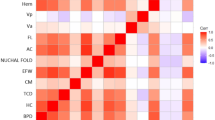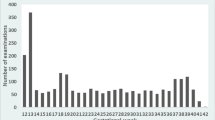Abstract
Objective:
The sonographic prediction of fetal macrosomia affects obstetrical decision regarding the timing and mode of delivery. We aimed to compare the accuracy of various formulas for prediction of macrosomia at different thresholds.
Study Design:
This was a retrospective cohort study of singleton gestations at term, with fetal biometrical measurements taken up to 7 days prior to delivery (2007 to 2014). Sonographic estimated fetal weight was calculated using 20 previously published formulas. Macrosomia prediction was evaluated for every formula utilizing: (1) measures of accuracy (sensitivity, specificity and so on); (2) comparison of the systematic and random errors (SE and RE), and the proportion of estimates within 10% of actual birth weight for macrosomic and non-macrosomic neonates. Performance measurements were evaluated for different macrosomia thresholds: 4000, 4250 and 4500 g. Best performing formula for every threshold was defined as the one with the lowest Euclidean distance (=SQRT(SE2+RE2)).
Results:
Out of 7977 women who met the inclusion criteria, 754 (9.4%) delivered a neonate weighing ⩾4000 g, 266 (3.3%) delivered a neonate weighing⩾4250 g and 75 (0.9%) delivered a neonate weighing⩾4500 g. Considerable variability was noted between the accuracy parameters of the different formulas, with Woo’s formula integrating Abdominal circumference (AC) and femur length (FL) as the most sensitive formula with the highest negative predictive value for all thresholds and Woo’s formula using AC, FL and biparietal diameter (BPD) as the most specific for all thresholds. The same formula also demonstrated the best overall accuracy. Regardless of threshold chosen, 80% or more of formulas demonstrated negative systematic error, meaning lower EFW than actual birthweight. As for the Euclidean distance, Hadlock’s formula (AC, FL and BPD) ranked the highest for the 4000 and 4250 g thresholds, whereas Shepard’s formula (AC and BPD) ranked the highest for the 4500 g threshold.
Conclusion:
Considerable variability exist between formulas for prediction of neonatal macrosomia. Formulas by Hadlock’s and Shepard’s utilizing AC, BPD±FL were most accurate for macrosomia prediction at 4000, 4250 and 4500 g thresholds, respectively.
This is a preview of subscription content, access via your institution
Access options
Subscribe to this journal
Receive 12 print issues and online access
$259.00 per year
only $21.58 per issue
Buy this article
- Purchase on Springer Link
- Instant access to full article PDF
Prices may be subject to local taxes which are calculated during checkout



Similar content being viewed by others
References
Koyanagi A, Zhang J, Dagvadorj A, Hirayama F, Shibuya K, Souza JP et al. Macrosomia in 23 developing countries: an analysis of a multicountry, facility-based, cross-sectional survey. Lancet 2014; 381: 476–483.
Boulet SL, Alexander GR, Salihu HM, Pass M . Macrosomic births in the united states: determinants, outcomes, and proposed grades of risk. Am J Obstet Gynecol 2003; 188: 1372–1378.
Zhang X, Decker A, Platt RW, Kramer MS . How big is too big? The perinatal consequences of fetal macrosomia. Am J Obstet Gynecol 2008; 198: 517 e511–e516.
Ye J, Torloni MR, Ota E, Jayaratne K, Pileggi-Castro C, Ortiz-Panozo E et al. Searching for the definition of macrosomia through an outcome-based approach. PLoS ONE 2014; 9: e100192.
Gabbay-Benziv R, Aviram A, Bardin R, Ashwal E, Melamed N, Hiersch L et al. Prediction of small for gestational age: accuracy of different sonographic fetal weight estimation formulas. Fetal Diagn Ther 2016; 40 (3): 205–213.
Aviram A, Yogev Y, Ashwal E, Hiersch L, Hadar E, Gabbay-Benziv R . Prediction of large for gestational age by various sonographic fetal weight estimation formulas-which should we use? J Perinatol 2017; 37 (5): 513–517.
Chitty LS, Altman DG, Henderson A, Campbell S . Charts of fetal size: 2. Head measurements. Br J Obstet Gynaecol 1994; 101: 35–43.
Chitty LS, Altman DG, Henderson A, Campbell S . Charts of fetal size: 3. Abdominal measurements. Br J Obstet Gynaecol 1994; 101: 125–131.
Chitty LS, Altman DG, Henderson A, Campbell S . Charts of fetal size: 4. Femur length. Br J Obstet Gynaecol 1994; 101: 132–135.
Dollberg S, Haklai Z, Mimouni FB, Gorfein I, Gordon E-S . Birth weight standards in the live-born population in Israel. Isr Med Assoc J 2005; 7: 311–314.
Hadlock FP, Harrist RB, Sharman RS, Deter RL, Park SK . Estimation of fetal weight with the use of head, body, and femur measurements—a prospective study. Am J Obstet Gynecol 1985; 151: 333–337.
Woo JS, Wan CW, Cho KM . Computer-assisted evaluation of ultrasonic fetal weight prediction using multiple regression equations with and without the fetal femur length. J Ultrasound Med 1985; 4: 65–67.
Warsof SL, Wolf P, Coulehan J, Queenan JT . Comparison of fetal weight estimation formulas with and without head measurements. Obstet Gynecol 1986; 67: 569–573.
Vintzileos AM, Campbell WA, Rodis JF, Bors-Koefoed R, Nochimson DJ . Fetal weight estimation formulas with head, abdominal, femur, and thigh circumference measurements. Am J Obstet Gynecol 1987; 157: 410–414.
Warsof SL, Gohari P, Berkowitz RL, Hobbins JC . The estimation of fetal weight by computer-assisted analysis. Am J Obstet Gynecol 1977; 128: 881–892.
Shepard MJ, Richards VA, Berkowitz RL, Warsof SL, Hobbins JC . An evaluation of two equations for predicting fetal weight by ultrasound. Am J Obstet Gynecol 1982; 142: 47–54.
Jordaan HV . Estimation of fetal weight by ultrasound. J Clin Ultrasound 1983; 11 (2): 59–66.
Hadlock FP, Harrist RB, Carpenter RJ, Deter RL, Park SK . Sonographic estimation of fetal weight. The value of femur length in addition to head and abdomen measurements. Radiology 1984; 150: 535–540.
Hsieh FJ, Chang FM, Huang HC, Lu CC, Ko TM, Chen HY . Computer-assisted analysis for prediction of fetal weight by ultrasound-comparison of biparietal diameter (BPD), abdominal circumference (AC) and femur length (FL). Taiwan Yi Xue Hui Za Zhi 1987; 86: 957–964.
Shinozuka N, Okai T, Kohzuma S, Mukubo M, Shih CT, Maeda T et al. Formulas for fetal weight estimation by ultrasound measurements based on neonatal specific gravities and volumes. Am J Obstet Gynecol 1987; 157: 1140–1145.
Combs CA, Jaekle RK, Rosenn B, Pope M, Miodovnik M, Siddiqi TA . Sonographic estimation of fetal weight based on a model of fetal volume. Obstet Gynecol 1993; 82: 365–370.
Ott WJ, Doyle S, Flamm S . Accurate ultrasonic estimation of fetal weight. Effect of head shape, growth patterns, and amniotic fluid volume. Am J Perinatol 1996; 3: 193–197.
Scioscia M, Scioscia F, Scioscia G, Bettocchi S . Statistical limits in sonographic estimation of birth weight. Arch Gynecol Obstet 2014; 291 (1): 59–66.
Melamed N, Yogev Y, Meizner I, Mashiach R, Pardo J, Ben-Haroush A . Prediction of fetal macrosomia: effect of sonographic fetal weight-estimation model and threshold used. Ultrasound Obstet Gynecol 2011; 38 (1): 74–81.
Chen P, Yu J, Li X, Wang Y, Chang C . Weight estimation for low birth weight fetuses and macrosomic fetuses in Chinese population. Arch Gynecol Obstet 2011; 284 (3): 599–606.
Alsulyman OM, Ouzounian JG, Kjos SL . The accuracy of intrapartum ultrasonography fetal weight estimation in diabetic pregnancies. Am J Obstet Gynecol 1997; 177: 503–506.
Hirata GI, Medearis AL, Horenstein J, Bear MB, Platt LD . Ultrasonographic estimation of fetal weight in the clinically macrosomic fetus. Am J Obstet Gynecol 1990; 162: 238–242.
Sokol RJ, Chik L, Dombrowski MP, Zador IE . Correctly identifying the macrosomic fetus: improving ultrasonographybased prediction. Am J Obstet Gynecol 2000; 182: 1489–1495.
Maruotti GM, Saccone G, Martinelli P . Third trimester ultrasound soft-tissue measurements accurately predict macrosomia. J Matern Fetal Neonatal Med 2016; 13: 1–5.
El Khouly NI, Elkelani OA, Saleh SA . Amniotic fluid index and estimated fetal weight for prediction of fetal macrosomia: a prospective observational study. J Matern Fetal Neonatal Med 2016; 22: 1–5.
Lindell G, Kallen K, Marsal K . Ultrasound weight estimation of large fetuses. Acta Obstet Gynecol Scand 2012; 91: 1218–1225.
Author information
Authors and Affiliations
Corresponding author
Ethics declarations
Competing interests
The authors declare no conflict of interest.
Additional information
Supplementary Information accompanies the paper on the Journal of Perinatology website
Supplementary information
Rights and permissions
About this article
Cite this article
Aviram, A., Yogev, Y., Ashwal, E. et al. Different formulas, different thresholds and different performance—the prediction of macrosomia by ultrasound. J Perinatol 37, 1285–1291 (2017). https://doi.org/10.1038/jp.2017.134
Received:
Revised:
Accepted:
Published:
Issue Date:
DOI: https://doi.org/10.1038/jp.2017.134
This article is cited by
-
Comparison of sonographic fetal weight estimation formulas in patients with preterm premature rupture of membranes
BMC Pregnancy and Childbirth (2021)
-
Birthweight thresholds for increased risk for maternal and neonatal morbidity following vaginal delivery: a retrospective study
Archives of Gynecology and Obstetrics (2018)



